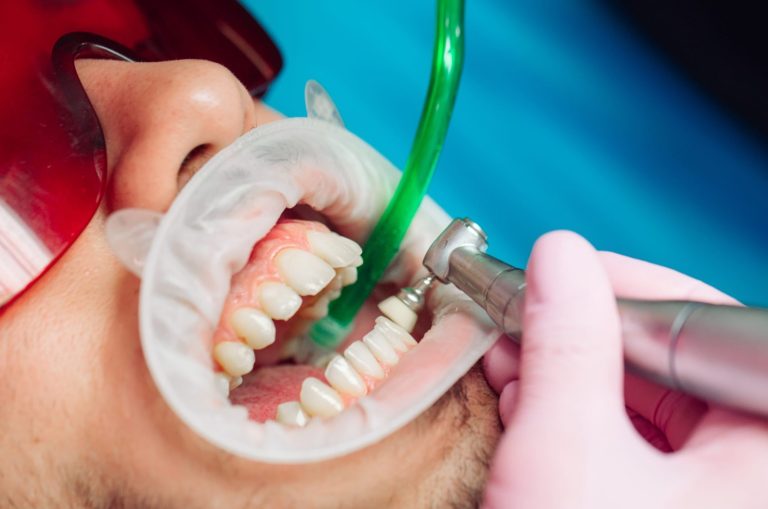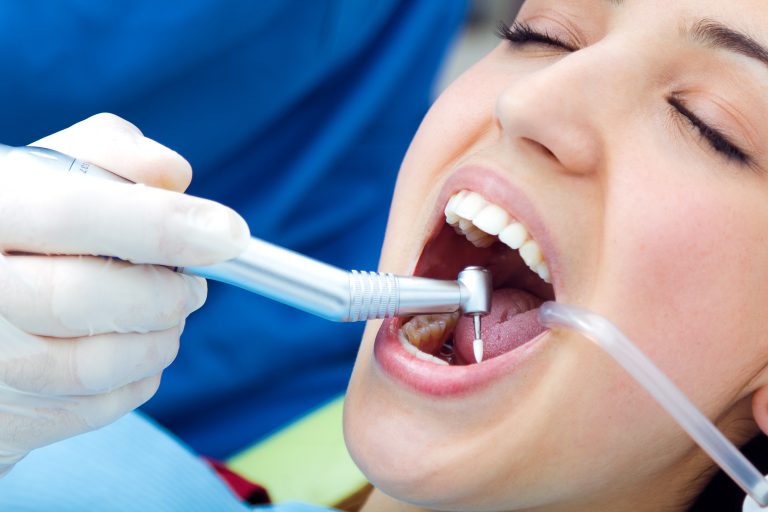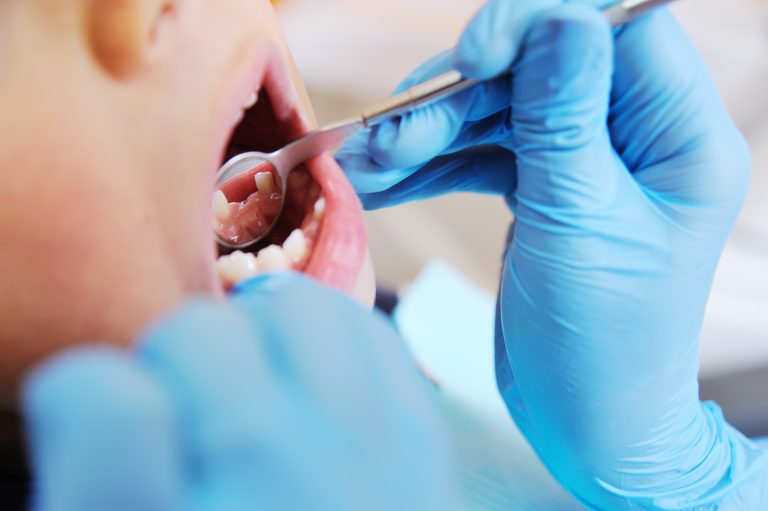


What is Dental Calculus?
Dental Calculus is a mineralized layer that forms as a result of plaque accumulation in the mouth hardening over time and sticks to the surface of the teeth. The formations that adhere tightly to the surface of the teeth harden under the influence of minerals such as calcium and phosphate in saliva. When the plaque layer is not cleaned with regular brushing and flossing, it turns into dental calculus over time.
Dental calculus is especially seen in areas close to the gums, on the back surfaces of the teeth and in areas close to the salivary glands. Its color can vary from yellow to brown and can negatively affect dental aesthetics over time. Hard dental calculus that cannot be cleaned with a toothbrush can create a suitable ground for bacterial plaques and lead to various problems that threaten oral health. Bad breath, gum disease and the risk of caries are among the most common results of plaque accumulation in the mouth. The resulting plaque can only be cleaned with professional methods. Therefore, regular check-ups and cleaning procedures should not be neglected.
What is Dental Calculus Cleaning?
Dental calculus cleaning is the process of removing hardened plaques that have adhered to the surfaces of the teeth with professional methods. The procedure is based on the dentist cleaning the stones using special tools without damaging the gums. During the procedure, the stones on the surface of the tooth are broken and separated from the tooth using ultrasonic devices or hand tools.
Removing tartar should not be considered as an application for aesthetic purposes only. It is also necessary for the protection of tooth and gum health. Stones that accumulate under the gum line can cause gum diseases over time. Tartar cleaning is usually painless and does not require local anesthesia. After cleaning, the teeth become smoother. Since it becomes difficult for bacteria to hold on, new plaque formation is delayed.
Tartar cleaning should be considered as a part of routine oral care. Dentists usually recommend tartar cleaning twice a year. However, the frequency may vary depending on the person’s oral structure and habits.
How is Tartar Cleaning Done?
Tartar cleaning is usually carried out in two stages. In the first stage, the stones on the surface of the tooth are broken down with the help of vibration given by the ultrasonic scaler device used by the dentist. The device breaks the stones with its high-frequency operating tips and removes them from the environment with the help of water. In this way, the remaining stones on the tooth surface are cleaned without damaging the gums.
In the second stage, the tooth surface is polished. Polishing is a polishing process performed with the help of a special paste. The purpose of this process is to make the teeth look brighter and to help remove the bacterial plaques remaining on the surface.
No pain is felt during tartar cleaning. However, temporary sensitivity may occur in individuals with gingivitis. The duration of the procedure varies depending on the intensity of tartar accumulation. It is usually completed in 20 to 40 minutes. After cleaning, slight bleeding or temporary tingling may be felt in the gums. These effects pass on their own in a short time.
How to Clean Tartar?
Tartars that cannot be removed with daily oral care methods can only be cleaned by dentists with special devices due to their hard structure. In other words, they cannot be eliminated by brushing or gargling at home. The surface of the tooth is not damaged during the cleaning process. Ultrasonic devices break down the stones thanks to high-frequency vibrations and remove them from the tooth with water spray. In some cases, hand tools are also used to clean the remaining residue. The roughness on the tooth surface is removed with the polishing process, making it difficult for plaques to reattach.
The cleaning process is planned specifically for the person. The duration of the session is determined by evaluating the mouth structure, tartar density and gum condition. Paying attention to oral hygiene after cleaning delays re-formation. Tartar cleaning plays an important role in protecting gum health when done regularly. It is recommended that the cleaning process be done intermittently. Otherwise, accumulated stones can cause gum inflammation and bone loss over time.
What are the Ways to Prevent Tartar Formation?
The most effective way to prevent tartar formation is regular and correct oral care. Brushing your teeth and flossing at least twice a day prevents plaque formation by reducing it. Oral care, especially before going to bed, prevents bacterial activity from increasing during the night. In addition to oral care, regular dentist check-ups should not be neglected. Plaques can be detected and cleaned early during these check-ups.
Excessive consumption of sugary and acidic foods can accelerate plaque formation. Oral hygiene should be provided after consuming such foods. Smoking is an important factor that increases tartar formation. The substances in cigarettes change the structure of saliva, facilitating mineral accumulation. It also weakens the defense mechanism of the oral environment by reducing the flow rate of saliva. Therefore, staying away from cigarettes is one of the preventive steps. Mouthwashes can be supportive in reducing plaque formation. However, if tartar has formed, it cannot replace cleaning.
What Conditions Can Tartar Cause?
Tartar does not only cause aesthetic problems. It also paves the way for serious oral health problems. The most common condition is gum disease. Tartar accumulates in the spaces between the gums and teeth, causing inflammation in this area. Gum bleeding, swelling and sensitivity are the first symptoms of this process. Inflammation that progresses over time can turn into a serious condition called periodontitis. Periodontitis causes the loss of the tissues and bone structure surrounding the teeth. As a result, teeth may become loose and tooth loss may occur.
Tartar is also one of the most important causes of bad breath. The odor that occurs as a result of bacterial accumulation can negatively affect social life. Yellowing and dull appearance of teeth are also among the effects caused by tartar. Unless tartar is cleaned, a suitable environment is created for the formation of cavities. Especially the stones that accumulate between the teeth make cleaning difficult and pave the way for the formation of cavities.
Who is More Commonly Seen with Tartar?
Tartar formation may vary depending on personal oral care habits, genetic factors and lifestyle. It is more common in individuals who neglect oral care. In people who do not brush their teeth regularly and do not use dental floss, plaque accumulation quickly turns into tartar.
In addition, tartar formation is more common in individuals who smoke. The chemicals in cigarettes change the structure of saliva, facilitating mineral accumulation. People with dry mouth are also at risk. Saliva has a natural cleansing feature. Decreased saliva flow accelerates plaque accumulation in the mouth. Tartar formation can also be observed in those who consume excessive sugary foods. In addition, since cleaning becomes more difficult in individuals who use braces, the possibility of tartar formation increases.
Genetic predisposition is also an important factor. Although some people have good oral care, tartar formation may develop more quickly due to the composition of their saliva. Although tartar is not limited to any age group, it is especially common in adults.
Does Having Tartar Cleaned Harm?
Tartar cleaning does not harm the tooth structure when performed by a specialist dentist. Ultrasonic devices used during the procedure only affect tartar. It breaks up tartar with vibration without damaging the tooth enamel and removes it from the environment. The polishing process smoothes the surface of the tooth, making it difficult for bacteria to adhere. Temporary sensitivity may occur in some individuals after cleaning. This condition usually goes away on its own within a few days.
Conditions such as gum recession or enamel erosion are not directly related to dental tartar cleaning. On the contrary, if this procedure is not performed, the risk of chronic inflammation and bone loss in the gums increases. When dental tartar cleaning is performed at regular intervals, the natural structure of the teeth is preserved. Cleaning without damaging the tooth enamel
The process is one of the most effective ways to protect oral health. Therefore, the process should be considered as a preventive and therapeutic application rather than a harmful one.
Stone Cleaning Procedure:
Stone cleaning is usually performed by a dentist or dental hygienist. The process may include the following steps:
First, the dentist performs an examination to see the tartar and takes x-rays if necessary.
Stone cleaning is usually done using a special tool. Ultrasonic tools can be used to soften and remove tartar and plaque. These tools clean the surface of the tooth with a combination of vibration and water.
The dentist then uses special teeth cleaning tools and abrasive substances to thoroughly clean the surface of the tooth.
The cleaning process usually extends below the gum line and the spaces between the teeth are also cleaned.
Finally, the teeth are polished and fluoride is applied if necessary.
Importance and Benefits:
Stone cleaning is important for maintaining the health of the teeth and gums.
Cleaning tartar helps prevent gum disease (such as gingivitis and periodontitis).
It improves oral hygiene and prevents bad breath.
It makes teeth look whiter and cleaner.
Aftercare:
After tartar cleaning, it is important to brush and floss your teeth regularly.
It is also important to keep regular checkups and visits to the dentist.
Tartar cleaning should be done as part of regular dental visits, usually once a year or every six months. This is an important part of maintaining your dental health and maintaining long-term oral hygiene.
Bize Mesaj Gönderin
Randevu Saatleri
Pazartesi – Cuma: 08:00 – 18:00
Pazar günleri ve resmi tatillerde kapalıyız.
İletişim
Yeni Mahallesi İntizam Sokak No:7 Pendik / İstanbul
0216 390 95 80
0505 372 09 26
Hasta Yorumları
Kliniğimizde, sıcak bir karşılama, şeffaf iletişim ve üstün hizmet kalitesiyle, diş sağlığı konusundaki tüm ihtiyaçlarınıza cevap vermeye hazırız.
Kaplamalarımla alakalı gitmiştim kaplamalarımın altında kistler oluşmuştu. İmplant takıldı şuan çok memnunum .Esra hanımdan önce 3 -4 tane dişçiye gittim ama hep problemler çıkardılar kaplamayı takarken dişlerimi kökten kırdılar. En son Esra hanımı önerdiler gittim ve çok memnun kaldım . Eli çok hafif ve işi bilen bir hekim Kanal tedavisi ile dişlerimin tamamını kurtardı. yakınlarıma,aileme tavsiye ettim . Ailemden de gidenler var.

TR
Esra hanıma komşumun tavsiyesi üzerine gittim iyi ki tavsiye etmiş iyi ki gitmişim çok memnunum implant yaptırdım tedavim hala da devam ediyor çok içten bir doktor hastasına güven veriyor ve çok rahatlatıyor ben de herkese tavsiye ederim

TR
Sıkça Sorulan Sorular: “Diş Taşı Temizliği“
Diş taşı temizliği genellikle yılda bir veya altı ayda bir düzenli diş hekimi ziyaretleri sırasında yapılmalıdır. Ancak kişinin diş ve diş eti sağlığına bağlı olarak bu sıklık değişebilir.
Diş taşı temizliği genellikle diş hekimi veya diş hijyenisti tarafından yapılır. Özel aletler ve cihazlar kullanılarak diş yüzeyinde biriken taşlar ve plaklar uzaklaştırılır.
Genellikle diş taşı temizliği ağrısız bir işlemdir. Ancak bazı hassas kişilerde hafif rahatsızlık hissedilebilir. Ağrı oluşmaması için diş hekiminiz lokal anestezi uygulayabilir.
Diş taşı temizliği, diş ve diş eti sağlığını korumak için önemlidir. Diş taşlarının uzaklaştırılmaması halinde diş eti hastalıklarına ve diş kaybına yol açabilir.
